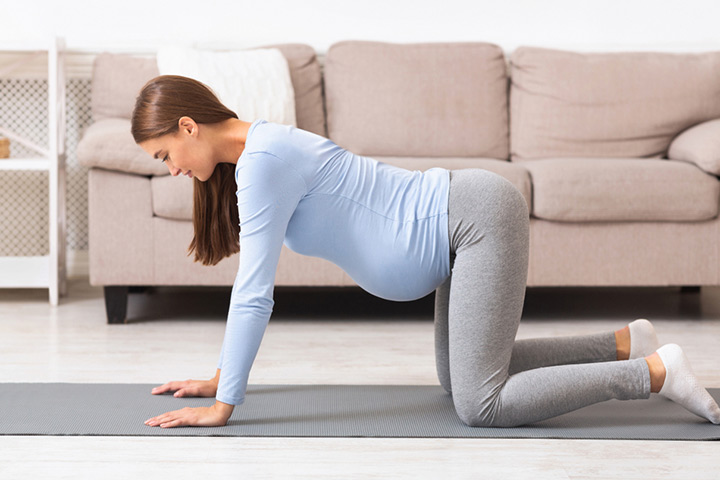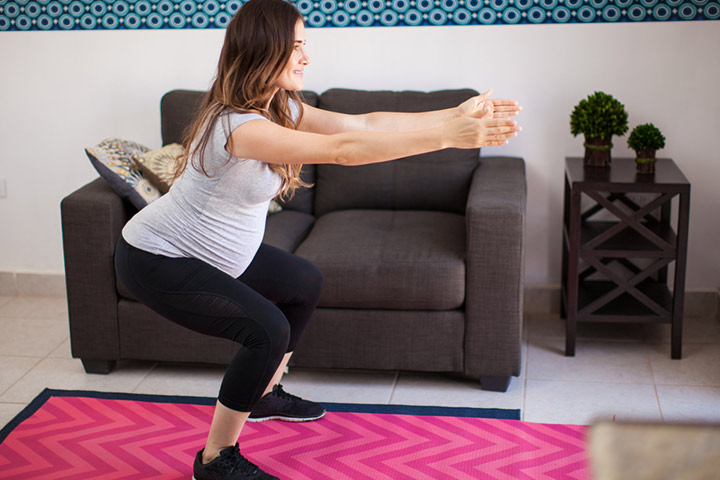
Image: Shutterstock
It doesn’t matter if you are a first-time mother or the mother of 5. The worst contractions and labor renders every pregnant woman catatonic. As the pregnancy progresses, you are slowly nearing the D day when you will be surrounded by a team of doctors in the OT. Many mothers want to stick to vaginal birthing to make the process more natural. While researching positions to make labor less painful, you will come across various poses that are the exact opposite of lying flat on your back. Then how did it emerge as the most popular pose for birthing, you ask? Well, we have all the answers. Read on to know the brief history behind birthing on the back and the list of alternative positions to induce painless labor.
Why Do Women Opt To Give Birth While Lying On Their Backs?
Image: Shutterstock
This might come as a surprise, but birthing while lying on the back was not popularized until the 1700s. The whole trend started because King Louis XIV was looking forward to seeing the birthing of his child. At that time, women labored with squatting tools, and midwives used to take the baby from floor level. But obviously, the King wouldn’t have let his potential successor grovel on the ground. So to make it look less frightful, the mistress was placed on the bed for birthing.
Following this, women of the King’s court started copying this position. However, it only made the work of the midwives more complex, and doctors were called in more often. Since it was of Royal stature, people started following it worldwide.
So now that you know how this position gained such popularity, you can laugh over it too! The position for labor has a lot of significance on how smooth your delivery will be. Here are a few positions to ease your labor.
1. Sitting
Image: Shutterstock
Sitting allows you to be upright and lets gravity assist you through laboring. It also promotes relaxation and is compatible with an epidural (1). You can use a ball or any type of chair to do it. You can also place the chair under the shower to make it more relaxing.
2. Walking
Walking is proven to speed up labor and make it less painful (2). Some people walk speedily through the neighborhood; others do it in their homes. It widens the pelvis and helps gravity assist the baby move down to your pelvis. You may not even feel the contractions while walking (3).
3. Forward Leaning
Image: Shutterstock
Leaning forward helps to take pressure off your back during labor (4). It can be done both while sitting and standing, and you can take the help of a stack of pillows or a ball. Some people like taking the support of a tub or a sturdy table. This is a comfortable position to take between your contractions and is believed to reduce the pain.
4. Tailor Sitting
Tailor sitting is basically sitting with your ankles crossed and your knees bent. It can be done on the floor or on the bed. The upright position takes the help of gravity and is very much relaxing. It stretches your inner thighs and back and helps you stay more comfortable during labor (5).
5. Semi-Sitting
Image: Shutterstock
Semi-reclining is mostly done by using a bed. You should not do it for extended periods, but it is still better than lying flat on your bed. It is believed to reduce labor pain and relax your muscles (6).
6. Lying On The Side
This position is a gravity-neutral position. It means that gravity does not help you in any way other than slowing down your birth. However, it can reduce pressure off the perineum and lower the risks of perineal trauma (7). It can be used in conjunction with other medications like epidural anesthesia. If the mother has high blood pressure, this position can be used for delivering the baby (8).
7. Squatting
Image: Shutterstock
The squatting position helps to widen the diameter of the pelvic outlet (9). However, it is essential to not use it till your baby is in your pelvis. It is also called the zero station. This is because it helps your baby descend into your pelvis and shortens the labor. This even feels good during the first and second stages of labor.
However, people have remarked that squatting could be correlated to increased blood loss during labor (10).
8. Hands And Knees
This is a gravity-neutral position that can help break the intensity of contractions. It is also a blessing for those with cervical lips. If the baby is in a posterior position and you face back labor, this position will help you reduce the discomfort (11). Your partner can massage your back or apply counterpressure to help you feel more comfortable.
9. Lunging
Image: Shutterstock
Lunging is when you position your foot on a sturdy stool or chair and lean in with the contractions. Lunging can widen your pelvis and make more room for the baby to move out. It will also lower your back pain during delivery (12).
Pregnancy is about dying to meet your baby while being petrified of the thought of delivery. To make it worse, people are always full of opinions when you ask them what is likely to happen during the birth. If you opted for a vaginal birth, it is courageous of you, but we suggest you research every bit of it so there are no surprises on the table! Also, even though childbirth is one of the most painful experiences the human body goes through, once you have your little one in your palms, it’s all worth it.


















